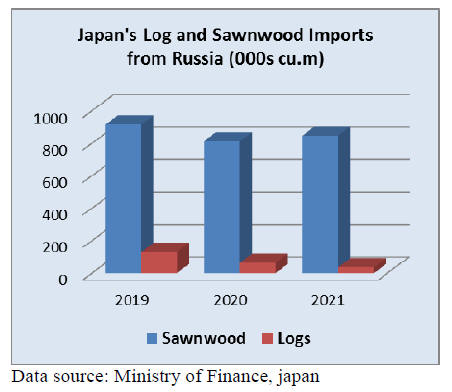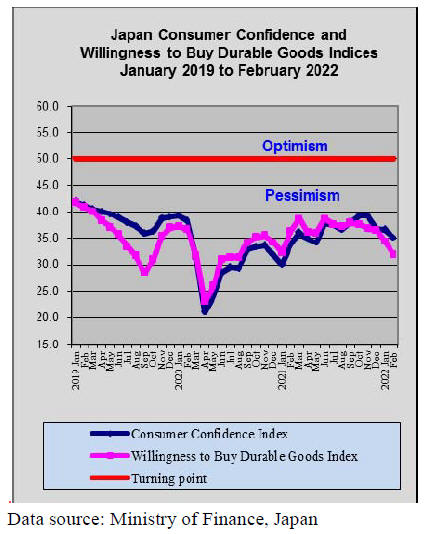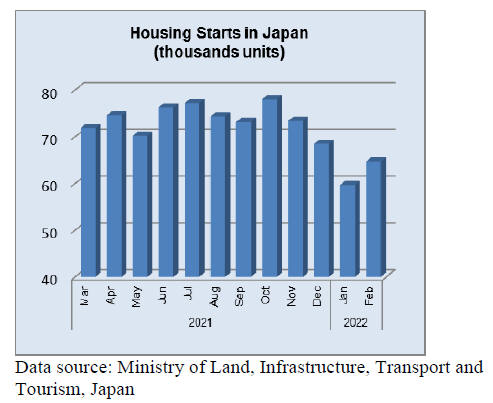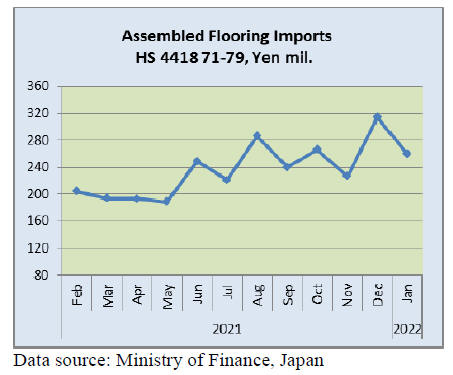Japan
Wood Products Prices
Dollar Exchange Rates of 25th
Mar
2022
Japan Yen 124.0
Reports From Japan
All restrictions lifted
The government has lifted all covid restrictions in the
remaining 18 prefectures where they were in place. This
decision comes as daily cases are around half the number
at the peak of the sixth wave and the hospital bed
occupancy rate for covid continues to decline.
See:
https://www.japantimes.co.jp/news/2022/03/16/national/coronavirus-emergency-travel-cases/
In related news, the government will raise the limit on
daily international arrivals in Japan to 10,000 from April
from the current 7,000 as strict border regulations have
been criticised by the private sector.
Economy faces downside risks
The March Cabinet Office report says country¡¯s economy
¡°continues to show movements of picking up, although
some weaknesses are seen¡±. This assessment is unchanged
from the February report in which the government lowered
its basic economic view for the first time in five months,
citing weakness in private consumption. However, the
report warns there are downside risks arising from the
Russian invasion of Ukraine.
See:
https://www.japantimes.co.jp/news/2022/03/25/business/economy-business/japan-economy-view-unchanged/
Russia bans wood product exports to Japan
The Russian government announced on 10 March that it
has stopped exporting logs, wood chip and veneer to
unfriendly countries in retaliation for the imposition of
sanction. Japan is one of the countries deemed ¡®unfriendly¡¯
by Russia.

Risng prices drives down confidence
Government data showed that consumer prices rose for the
sixth straight month in February as households paid more
for gasoline and electricity.
The data indicated that energy prices surged 20%, the
biggest rise in over 40 years. Petrol prices surged 22% and
food prices rose by around 3%. If this continues consumer
confidence will be driven lower.

Serious earthquake rocks eastern Japan
A very strong earthquake shook Japan mid-month
damaging a large number of homes and leaving 3 people
dead. The quake also disrupted transportation systems and
supply chains in northeast of the country.
Marriages drop to post war low
The Ministry of Health, Labor and Welfare has released
population statistics showing a further decline in the birth
rate in 2021, the sixth consecutive year of decline. The
number of marriages also declined to a postwar low.
The decline in births is bound to continue as the marriage
rate drops and this will have an impact on demand for new
homes.
See:
https://www.nippon.com/en/japandata/h01267/?cx_recs_click=true
February 2022 housing starts rose 8% year on year and jumped
11% compared to January. As the weather improves building
activity picks up.

Yen at 5 year low
The yen is facing strong downward pressure against the
US dollar raising the risk to the Japanese economy as the
cost of imports will rise, a situation aggravated by the
Russian invasion of Ukraine.
A recent decision by the Bank of Japan (BoJ) to extend the
loose monetary policy while other developed countries are
scaling back economic stimulus to dampen inflation drove
the yen to its lowest in five years. Mid March the yen was
trading at 119 to the US dollar.
See:
https://www.nippon.com/en/news/yjj2022031501080/

Import update
Wooden door and window imports
The Ministry of Finance has not published January 2022
import data for either wooden doors (HS441820) or
wooden windows (HS441810).
Assembled wooden flooring imports
Despite the dip in the value of assembled flooring
(HS441871-79) imports in January this year there has been
a steady upward trend in the import value since May 2021.
Year on year, assembled wooden flooring imports were up
56% in January 2022 but the January figure was down by
17% compared to that in December 2021.
The main category of assembled flooring imported by
Japan is HS441875 accounting for around 70% of January
2022 imports with the main suppliers being China and
Vietnam and Malaysia. The second ranked category in
terms of value of imports was HS441879 shipped mainly
from China, Thailand and Vietnam.

Plywood imports
There was a surge in imports of plywood (HS441210-39)
in January this year due to rising demand and a drop in the
availability of plywood manufactured from domestic raw
materials. Year on year, January 2022 plywood import
volumes rose 14% and compared to a month earlier
January import volumes were also 14% higher.

Malaysia and Indonesia are the main plywood shippers
to
Japan and in January 2022 shipments from Malaysia rose
sharply to a level not seen since March 2021. In contrast
shipments from Indonesia eased slightly in January.
The other significant shippers of plywood to Japan are
China and Vietnam and in January shipments from China
were up month on month while those from Vietnam fell
slightly.

Of the various categories of plywood imported in
January
2022 (as in other months) HS441231 was the most
common accounting for almost 90% of imports.
Trade news from the Japan Lumber Reports (JLR)
The Japan Lumber Reports (JLR), a subscription trade
journal published every two weeks in English, is
generously allowing the ITTO Tropical Timber Market
Report to reproduce news on the Japanese market
precisely as it appears in the JLR.
For the JLR report please see:
https://jfpj.jp/japan_lumber_reports/
Russia bans export of wood products
The Russian government announced on March 10 that it
stops exporting logs, wood chip and veneer to unfriendly
countries for retaliation of the sanctions the Western
nations taken for the invasion of Russia to Ukraine.
Log export has been banned already so there is no damage
but users of wood chip and veneer will suffer greatly.
Particularly veneer is important material to maintain
quality of plywood so the Japanese plywood
manufacturers need to find substituting sources in a hurry.
Lumber is not included in this measure.
For Japan, larch KD veneer from Terneiles, Plastin,
Primorski Krai and RFP, Khabarovsk are immediate
product. Both exports about 250,000 cbms a year from
these two sources. Larch veneer has high strength and it is
kiln dried so plywood mills in Japan do not have to dry it,
which makes operations efficiently.
Since plywood mills struggle to secure enough raw
material like domestic cedar logs, stop of Russian veneer
supply is really hard blow. Plywood mills are now looking
for substitutions such as eucalyptus, beech, birch, Douglas
fir, radiate pine but immediate supply is difficult.
Actually target of this measure is European countries,
where Russian wood chip is consumed in large volume for
fuel and paper manufacturing. In Europe, wood products
supply from Russia, Ukraine and Belarus are significantly
important.
It is said that lumber export from Russia to the European
countries is 5.2 million cbms so once such supply is
disrupted export of European wood products for the North
America and Japan would drop down and the prices would
soar. This could be another wood shock.
Plywood supply
The shipping of domestic plywood has been exceeding
production. The volume of imported plywood was over
250,000 cbms for the first time in three years. About
80,000 cbms of plywood were imported from Malaysia,
same volume as Indonesia. Volume of over 80,000 cbms
continued from Indonesia for straight two months.
The volume of imported plywood from Malaysia and
Indonesia increased because there was a delay of arrival
by a Japanese New Year¡¯s holiday.
There was another reason that a busy exporting plywood
to North America from Malaysia or Indonesia peaked out
and they shipped more for Japan.
Shortage of imported South Sea hardwood plywood had
slightly solved. However, since one of major plywood
companies in Malaysia stopped accepting new orders in
November, 2021, the imported volume would be low in
February 2022. This situation would continue until March.
Some plywood companies in Malaysia and Indonesia are
suffering a lack of logs. They have a very few orders
which are a half of usual amount of orders.
There is not enough supply of softwood plywood in Japan
due to a New Year¡¯s holiday and a heavy snow covered in
North Eastern Japan. There were not enough domestic logs
and larch laminated veneer from Russia. Plywood mills
are not able to increase the production despite active
orders.
On the other hand, the shipping was firm. According to
Japan Plywood Manufacturers¡¯ Association, a final
inventory at the end of January was 77,000 cbms, which
was 1,400 cbms less than December, 2021. This is only
0.3 month supply based on shipping volume. Some
plywood manufacturers in Japan say that shipping will be
more than production in February and March.
South Sea logs and lumber
Malaysia and Indonesia are in the middle of rainy season
so log production is extremely low since late February.
Local plywood mills in Malaysia continue struggling to
secure logs then labor shortage continues after Indonesian
workers are not able to work in Malaysia because of
corona epidemic.
PNG is also in rainy season so log production is way down
and arranging ship¡¯s space become difficult after volume
for Japan becomes minimal.
South Sea lumber manufacturers secure ample logs to cut
but truck body lumber demand is inactive because truck
manufacturing is delayed by shortage of semi-conductor.
South Sea hardwood veneer started arriving after it
delayed by container shortage.
Dealers of Chinese made laminated free board in Japan
have ample inventory and contract balance so they are in
no hurry to make future contract. Chinese manufacturers
maintain present prices with high cost of Russian red pine
lumber and adhesive.
There is no influence of Russian invasion to Ukraine but it
may be good reason to maintain the prices.
Indonesian mercusii pine lumber is arriving much
smoothly after container shortage problem eased but there
is no excessive import. After all, supply and demand
balance well by tight supply during rainy season and
stagnating demand in Japan.
Sumitomo Forestry¡¯s business plan
Sumitomo Forestry Co., Ltd., announced a mid- to-long
term business plan. The plan is about aiming carbon zero
society by expanding forest and using wood in the future.
The company sets the goal at 2,500 billion yen of
recurring profit in 2030.
Reducing CO2 by maintaining and expanding forest is one
of the goals and logging and reforestation at aged manmade
forest in Japan is as well. For details, Sumitomo
keeps a total of 279,000 hectares in Indonesia, Papua New
Guinea, NZ and including 48,000 ha in Japan. Then it will
expand the forest land to 500,000 hectares by adding the
area in Australia, North America and South America.
10,000 billion yen will be used for managing plan of
global forest fund.
The company also launches a new section which involves
a management of forest business and a weather satellite for
controlling the forest growing. It will build wooden
industrial complex in Japan by investing 200 billion yen
for three years. Target is about 1,000,000 cbms of
domestic logs will be consumed as of 2030.
As the first step, Sumitomo will build a new biomass
energy plant at Shibu city in Kyusyu area and starts
operating it in 2025. In this area, majority of logs are
exported but Sumitomo plans to make value added
products from local logs and export will be four locations
of wood processing complex, which are medium size
wood processing plant with consumption of 200,000-
300,000 cbms of logs.
In section of construction department, Sumitomo will
promote decarbonizing and LCCM housing as standard on
the process of planning. Sumitomo will build a six-story
building in London, the United Kingdom with calculating
the volume of CO2. Sumitomo has built 11,230 units in
the United States, 3,169 units in Australia and 2,534 units
in other countries. They will build 23,000 units in the
United States and 5,500 units in Australia and 11,500 units
in other countries. 10,000 units will be built in Japan as
well. The total units will be 50,000 units in 2030.
Sumitomo¡¯s target figure for sales of building materials in
2024 is 2,640 billion yen, 21.7% more than December,
2021. Housing in overseas and the real estate business is
9,540 billion yen, which will be 48% more from
December, 2021.
Housing and construction in Japan are 5,470 billion yen,
7.1% increasing. Resource and environment are 265
billion yen, 18.8% more than December, 2021. The total
sales will be 1 trillion and 7,700 billion yen, 27.7% more
than December 2021 and the recurring profit will be 1,730
billion yen, 25.6% increasing.
Sumitomo plans for building 9,750 units in Japan, 0.4%
increasing from December, 2021. 16,000 units in the
United States. This is 42.5% more than before. 4,000 units
in Australia. This is 26.2% increasing.
|